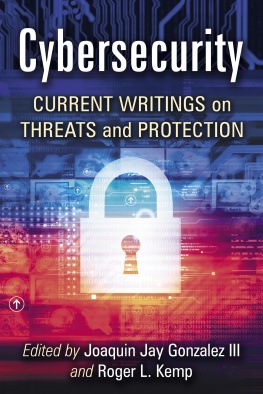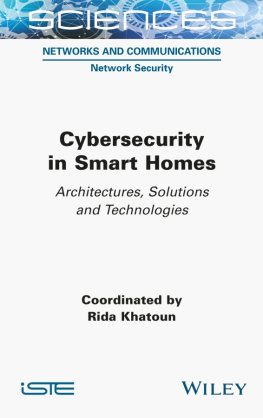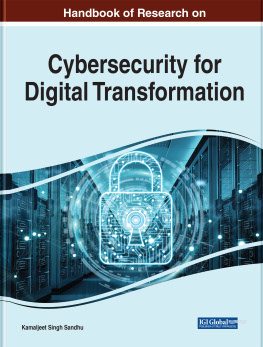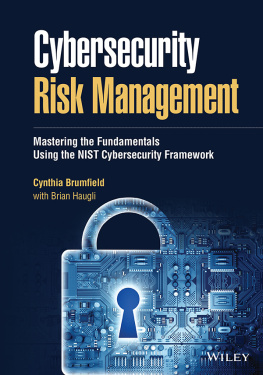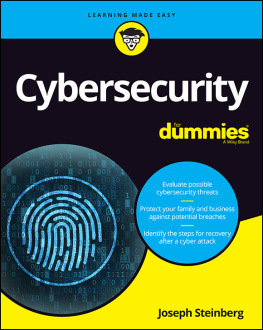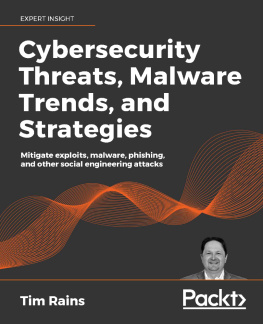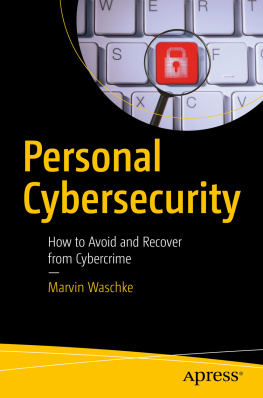
Cybersecurity
Current Writings on Threats and Protection
Edited by JOAQUIN JAY GONZALEZ III and ROGER L. KEMP

McFarland & Company, Inc., Publishers
Jefferson, North Carolina
ALSO OF INTEREST AND FROM MCFARLAND
Legal Marijuana: Perspectives on Public Benefits, Risks and Policy Approaches,edited by Joaquin Jay Gonzalez III and Mickey P. McGee (2019)
Eminent Domain and Economic Growth: Perspectives on Benefits, Harms and New Trends, edited by Joaquin Jay Gonzalez III, Roger L. Kemp and Jonathan Rosenthal (2018)
Small Town Economic Development: Reports on Growth Strategies in Practice,edited by Joaquin Jay Gonzalez III, Roger L. Kemp and Jonathan Rosenthal (2017)
Privatization in Practice: Reports on Trends, Cases and Debates in Public Service by Business and Nonprofits, edited by Joaquin Jay Gonzalez III and Roger L. Kemp (2016)
Immigration and Americas Cities: A Handbook on Evolving Services, edited by Joaquin Jay Gonzalez III and Roger L. Kemp (2016)
Corruption and American Cities: Essays and Case Studies in Ethical Accountability, edited by Joaquin Jay Gonzalez III and Roger L. Kemp (2016)
LIBRARY OF CONGRESS CATALOGUING DATA ARE AVAILABLE
BRITISH LIBRARY CATALOGUING DATA ARE AVAILABLE
e-ISBN: 978-1-4766-3541-5
2019 Joaquin Jay Gonzalez III and Roger L. Kemp. All rights reserved
No part of this book may be reproduced or transmitted in any form or by any means, electronic or mechanical, including photocopying or recording, or by any information storage and retrieval system, without permission in writing from the publisher.
Front cover image 2019 Shutterstock
McFarland & Company, Inc., Publishers
Box 611, Jefferson, North Carolina 28640
www.mcfarlandpub.com
Jay dedicates this book to Elise and Coral,
the next generation
Roger dedicates this book to Anika,
the best and the brightest
Acknowledgments
We are grateful for the support of the Mayor George Christopher Professorship at Golden Gate University, and GGUs Pi Alpha Alpha Chapter. We appreciate the encouragement from Dean Gordon Swartz and our wonderful colleagues at the GGU Edward S. Ageno School of Business, the Department of Public Administration, and the Executive MPA Program.
Our heartfelt Thanks! go to the contributors listed in the back section and the individuals, organizations, and publishers below for granting permission to reprint the material in this volume and the research assistance. We are particularly grateful to the International City/County Management Association or ICMA (icma.org), for permission to reprint a significant number of selections in this volume. The ICMA advances professional local government management through leadership, management, innovation, and ethics.
American Libraries
American Society for Public Administration
Anne Ford
Arun Vishwanath
Beth Payne
Benjamin Dean
Brian McLaughlin
Caitlin Cowart
Chelsea Binns
The Conversation
Dorothy Denning
e.Republic, Inc.
Federal Bureau of Investigation
Frank J. Cilluffo
Fred H. Cate
GCN Magazine
Golden Gate University Library
Governing
Government Finance Officers Association
Government Finance Review
Government Technology
James H. Hamlyn-Harris
John OBrien
Kaiser Health News
Lichao Zhang
Mark Banks
Mark Kennedy
Michelle F. Hong
Mick McGee
NACo County News
National Association of Counties
Nir Kshetri
PA Times
Paul D. Harney
The Pew Charitable Trusts
PM Magazine
Public Management (PM) Magazine
Richard Forno
San Francisco State University
Scott Shackelford
Sharon L. Cardash
Texas Workforce Commission
Theodore J. Kury
U.S. Department of Commerce
U.S. Department of Homeland Security
U.S. Department of Justice
University of San Francisco Library
William Hatcher
Preface
We live in a cyber age. The Internet of Everything (IoE) is here and growing. Big data is getting bigger and bigger. Billions of people are connected by billions of devices across cities and countries. While walking or driving, while in our homes or offices, wherever and whenever, personal and professional information are being received and transmitted. Selling to millions of customers and providing mass public services are now easily done through phones, tablets, and laptops. However, this widespread access has come at a significant sacrifice. Hackings and cybercrime have emerged as threats. Our businesses and governments are under siege and so are our privacy and democracy. How could security be restored in this complex cyber world?
This timely volume was researched with answers to this important question in mind. We compiled best practices and experiences from the evolving and dynamic field of cybersecurity. Our contributors, who come from diverse professions and backgrounds, report on the current and emerging threats and the risks as well as the available preventive measures and protections. These practical, easy-to-read cybersecurity lessons and suggestions are for individuals, organizations, and communities.
For ease of reading, and reference purposes, we divided this book into four major sections, which are highlighted below to provide the reader with detailed information about the content of this cybersecurity reference book.
Part IAn Overview
We begin this volume with a general overview of the digital dilemma we live and work in. Our contributors and we believe this rapidly evolving context is the source of both the goodand the bad and thus the need for cybersecurity.
The Internet of Everything, which encompasses people, devices, processes, and data, has created a lot of benefits but there are also a lot of costs. Chapters 1 through 5 describe the bad side of our electronic world. As giant repositories of citizens information, governments, especially at the city and county level, are constantly under attack, sometimes without employees knowing it. The negative impact, especially cybercrime, has been increasing as well as the hacking risks.
But surely, it seems, the benefits far outweigh these risks and costs. After all, according to Chapters 6 to 9, moving to digital transactions and operations have made public and private services more responsive, open, speedy, and transparent. Moreover, advanced performance and data analytics have enhanced our capacity to process a cyber world where big data is now characterized with unprecedented volume, velocity, value, veracity, and variety. These daily data exchanges, e.g., texts, photos, tweets, are in the trillions. What are the privacy protections promised by public agencies and private companies? Are they really adequate?
Part IIThreats and Risks
Part II fleshes out the specifics of the badthe many threats and risks that directly relate to individual, organizational, societal, and global cybersecurity. More than a dozen chapters (from 10 to 22) are included in this section of our national reference volume examining the threats of a hard to manage Internet of Things (IoT) industry and the risks of stockpiling Zero-Day software vulnerabilities.
We agree with our contributors who underscore both the quantity and quality of these threats and risks. Several chapters delve into the basics and experiences of database breaches, domestic and international hacking, covert espionage, denial of service attacks, phishing, spyware, ransomware, and the weak defenses of social media. Going even deeper, Chapter 15 distinguishes between the different types of hackers and hacks. Part II also includes graphic examples of cybersecurity lapses from court, healthcare, credit reporting, utility, transportation, and county organizations.
Next page
